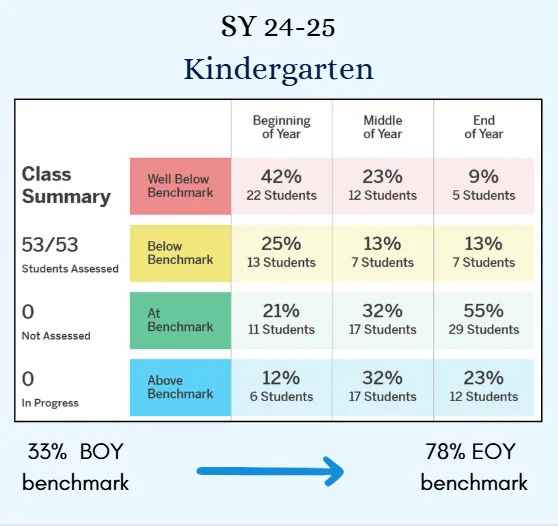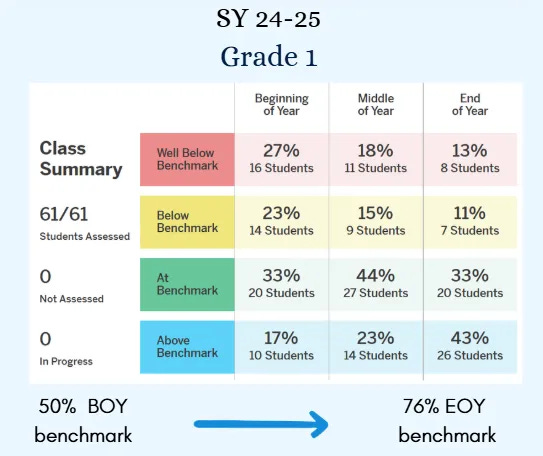A Daunting Beginning
When I joined a new school district as a reading specialist in 22-23, my primary focus was to provide intervention. With only 37% of first graders meeting the BOY benchmark, I was completely overwhelmed with the amount of students I was going to have to help in that grade alone. I felt like it was on me to “fix” them.
I had been using UFLI’s virtual teaching hub since 2020, so when I learned that they were releasing a structured literacy program with a manual, I had to have it. I knew UFLI Foundations would be the perfect tool to help these students who were learning through balanced literacy in their classrooms.
I jam-packed my schedule, wrote my goals around first grade, purchased my own UFLI Foundations manual, and did everything I could to intervene my way out of what was really a Tier 1 problem. After a few months, some of the first grade teachers jumped in and discreetly purchased their own UFLI manuals as well. Ultimately, the first grade did make some good improvements, ending the year with 65% of first graders meeting the benchmark - but then I saw the EOY kindergarten data. Only 43% of kindergartners met the end of year goal. Once again, more than half of the incoming first graders were going to require intervention. All that hard work, and I’d have to do it again next year. It was completely unsustainable. If nothing changed in kindergarten, I was going to be facing the exact same problem with next year’s first graders.
Prevention Before Intervention
The good news is something did change. Word got out about UFLI, and the district decided to implement UFLI Foundations k-2, offering in-person training with UFLI team members.
Since then, my top priority has been to prevent students from requiring intervention in the first place. On a podcast, I heard Stephanie Stollar say, “Prevention is the best intervention,” and that has been my motto ever since. At the 23-24 kindergarten screening, I informally assessed incoming students’ phonological awareness and familiarity with letters and sounds. When kindergartners started that school year, I knew exactly who would need my extra attention from day 1. But I didn’t support only those students. I dedicated 30 minutes per day in each kindergarten classroom to model and support UFLI implementation, and provide practice for students. At the end of that year, 73% of kindergartners met the benchmark. This school year, I continued to prioritize prevention in kindergarten, and we ended the school year with 78% meeting the benchmark.
Now What?
If you told me 2 years ago that we’d have almost 80% of kindergartners meeting the end of year benchmark, I would have been over the moon. Don’t get me wrong, I am pleased with the progress. I think 43% to 78% in two years is great! But after learning more about reading outcomes and MTSS through invaluable resources like It’s Possible (Hanlin & Montgomery, 2024), MTSS for Reading Improvement (Brown & Stollar 2025), and joining the Reading Science Academy, I’m now seeing that 78% meeting benchmark means 22% of students are not achieving that success, and I’m not okay with settling for that. 78% is telling me that we still have more work to do to get all kids meeting grade level expectations.
The district adopting UFLI Foundations K-2 played an enormous role in the progress that we’ve made. It got everyone on the same page and really improved core instruction. While we saw a lot of progress from the beginning to end of this year, we’re still below 80% meeting benchmark in K and 1.


Can we and will we continue to provide Tier 2 and Tier 3 intervention for those who need it? Yes, but we can also continue to strengthen our Tier 1.
Focus on Implementation
One way we can help more students be successful in Tier 1 is by looking into our UFLI Foundations implementation and making sure that all teachers are implementing the program as it was designed. As a reading specialist who visits many classrooms throughout the day, I see UFLI in action frequently., Eand even though it’s being done mostly correctly, there are many nuances that I see varyvaried from class to class. Teachers might not be aware of these slight variations, as they’re focused on their own instruction. A focus point I have for next school year is to have conversations regarding consistency in implementation, using the Lesson Planning & Implementation Support guide as a starting point.
Through the use of the Collaborative Improvement Cycle (MTSS for Reading Improvement is my go-to guide for this), teams can work together to identify and clean up some of those UFLI routines that have proven to be harder to nail down. It could be just what some of our students need to get to the next level!
There are a few components that come to my mind that are the most difficult to implement consistently:
Pay attention to pacing
It’s important to remember that each lesson is only intended to be 30 minutes per day. If you do every word in the blending drill and word work section, and dictate all 3 sentences for students to write, you’ll never get through in 30 minutes, especially in kindergarten. (Think “Anita Archer Perky Pace”). Be sure to follow the recommended pacing on page 21 of the manual. Once you hit your time for each step, move on! And for a handy reminder, I love the Lesson Step Pocket Reference available in the UFLI Toolbox!
Use connected phonation
How many students have you had try to sound out a word like this. The word is map, and the student sounds out “/m/ /a/, /p/. . . pat!” Those 3 separate sounds are just too much for some of our students to work with. UFLI recommends (and research supports) using connected phonation in your lessons - that is, stretching out each sound and then blending, “/mmmaaaap/. . . map.” Check out what it looks like!
Model blendable sounds
Speaking of connected phonation, in order for this to work, we need to model blendable sounds. Continuous sounds should be stretched out, and stop sounds should be clear, without a schwa added to the end. Check out what it looks like!
Alternate encoding and decoding with Word Work: Step 6.
Your prompting during the word work section is going to dictate whether students are decoding or encoding, and we need to be doing both. When you prompt students to build or change a word without telling them which letters to use, they are encoding. An example of an encoding prompt is, “Change mop to top”. When you tell students which letters to use and ask them to read it, they are decoding. A decoding prompt could be something like, “Change the O in top to an A. What’s the new word?” Alternate between the two types of prompts. Check out what it looks like!
Don’t leave out the connected text
With only 15 minutes allotted to cover sentence reading, sentence writing, and decodable text reading, the decodable text can feel daunting and might be tempting to drop from the end of the lesson. Although many teachers choose to have students highlight the new concepts, draw an illustration on the printable passage, etc., all you need to do in the actual 30 minute lesson is choral read the passage from the slides!
Using progress monitoring assessments to guide instruction
The progress monitoring spelling assessments are meant to guide your small group instruction. They’re not meant to be used as a spelling test that is graded and sent home, and remember, mastery is not expected immediately after each concept is introduced! This new tool from UFLI and Project Read could be a game changer for using these assessments to guide your small group instruction.
Shifting from “Student-level” to “Systems-level” Decision-Making
Up until recently, I’d mostly been using my school’s DIBELS data to identify students who need intervention and to monitor progress. In their MTSS book, Brown and Stollar refer to this as “student-level focus”. They point out that when more than 20% of students are performing below grade level, the intervention system is likely to be overwhelmed and not very effective, and they recommend using data to inform “system-level” decisions (Brown & Stollar, 2025). I’ve found that, as the main person responsible for providing intervention, I’ve really felt the brunt of that intervention system overwhelm. By placing more of an emphasis on how we can improve our systems, not just how we can intervene, fewer students will require intervention.
While we’re working on improving the implementation of the instruction that is provided in Tier 1, I’d also like to consider where Tier 1 instruction might need to be more differentiated in grade levels where fewer students are meeting grade level expectations. One webinar that really piqued my interest regarding differentiating Tier 1 instruction was this one from Stephanie Stollar and Linda Diamond. Since less than 80% of students in each grade level of my school are meeting benchmark (especially in grades 2 and up), I’m considering how we can increase our differentiation to meet students where they are in Tier 1, and accelerate their learning in Tier 2 and/or Tier 3. I highly recommend watching the recording if you are interested in this topic!
Moving Forward
One thing I love about summer vacation (aside from the sun, the beach, creating family memories, etc.) is that it offers a chance to reflect, pause, and begin again but better. Using data to reflect upon progress is crucial to continuing to improve. This year was better than last year, and last year was better than the one before that. Now that I’ve done my fair share of reflecting, it’s time for that pause to step away from this year’s data and refresh before beginning next year better.
References
Brown, S., & Stollar, S. (2025). Mtss for Reading Improvement: A Leader's Tool Kit for Schoolwide Success (Reading Science in Action: An Mtss Tool Kit). Solution Tree.
Montgomery, P., & Hanlin, A. (2024). It's Possible! A Leadership Plan for Implementing Quality Reading Instruction and Ensuring Literacy for All. Solution Tree.
Stollar, S., & Diamond, L. (2025, March 4). Dispelling Tier 1 Misconceptions: Why We Need Differentiated Literacy Instruction. edWeb. Retrieved June 21, 2025, from https://home.edweb.net/webinar/literacyhero20250304/






Love this perspective! I had the sane take-away. Systems level change is so necessary. There is no way around it. And it takes constant tweaking and learning and applying, but I’ve also learned I can help change systems.
What a wonderful post! And, wonderful news! Congratulations to you, especially for this leadership, and to your teachers and kids for such great work.
I just love the ‘we got this far, how to get further’ approach to this essay.
Well done!